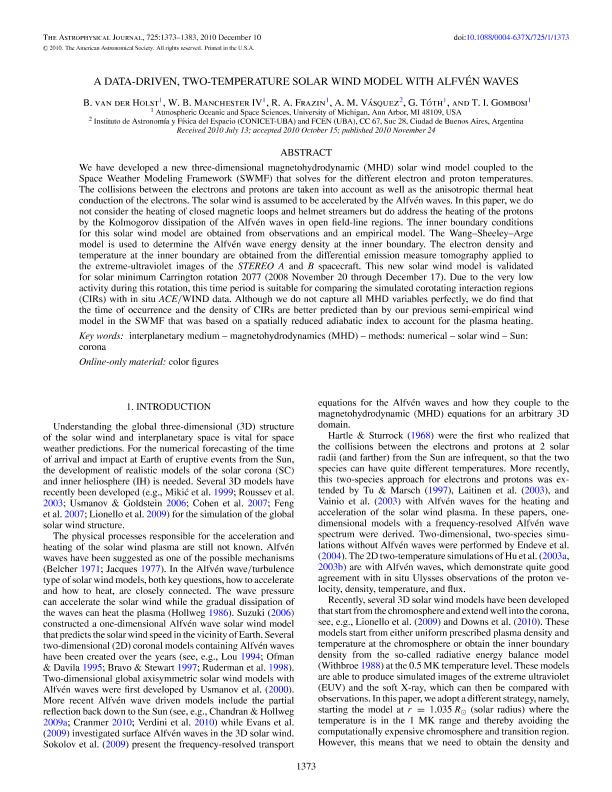Artículo
A data-driven, two-temperature solar model with Alfven waves
van der Holst, B.; Manchester IV, W. B.; Frazin, R. A.; Vasquez, Alberto Marcos ; Tóth, G.; Gombosi, T. I.
; Tóth, G.; Gombosi, T. I.
 ; Tóth, G.; Gombosi, T. I.
; Tóth, G.; Gombosi, T. I.
Fecha de publicación:
10/12/2010
Editorial:
IOP Publishing
Revista:
Astrophysical Journal
ISSN:
0004-637X
Idioma:
Inglés
Tipo de recurso:
Artículo publicado
Clasificación temática:
Resumen
We have developed a new three-dimensional magnetohydrodynamic (MHD) solar wind model coupled to the Space Weather Modeling Framework (SWMF), that solves for the different electron and proton temperatures. The collisions between the electrons and protons are taken into account as well as the anisotropic thermal heat conduction of the electrons. The solar wind is assumed to be accelerated by the Alfv en waves. In this paper, we do not consider the heating of closed magnetic loops and helmet streamers, but do address the heating of the protons by the Kolmogorov dissipation of the Alfv n waves in open field line regions. The inner boundary conditions for this solar wind model are obtained from observations and an empirical model. The Wang-Sheeley-Arge model is used to determine the Alfv n wave energy density at the inner boundary. The electron density and temperature at the inner boundary are obtained from the differential emission measure tomography applied to the extreme ultraviolet images of the STEREO A and B spacecraft. This new solar wind model is validated for solar minimum Carrington rotation 2077 (November 20 through December 17, 2008). Due to the very low activity during this rotation, this time period is suitable for comparing the simulated Corotating Interaction Regions (CIRs) with in-situ ACE/WIND data. Although we do not capture all magnetohydrodynamic variables perfectly, we do find that the time of occurance and the density of CIRs are better predicted than by our previous semi-empirical wind model in the SWMF that was based on a spatially reduced adiabatic index to account for the plasma heating.
Palabras clave:
Solar Wind
,
Mhd
,
Sun: Corona
,
Sun: Waves
,
Interplanetary Medium
,
Methods: Numerical
Archivos asociados
Licencia
Identificadores
Colecciones
Articulos(IAFE)
Articulos de INST.DE ASTRONOMIA Y FISICA DEL ESPACIO(I)
Articulos de INST.DE ASTRONOMIA Y FISICA DEL ESPACIO(I)
Citación
van der Holst, B.; Manchester IV, W. B.; Frazin, R. A.; Vasquez, Alberto Marcos; Tóth, G.; et al.; A data-driven, two-temperature solar model with Alfven waves; IOP Publishing; Astrophysical Journal; 725; 1; 10-12-2010; 1373-1383
Compartir
Altmétricas



